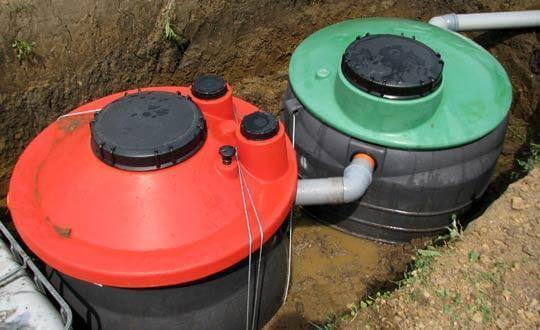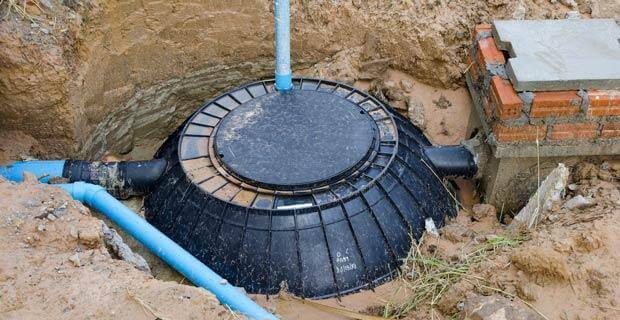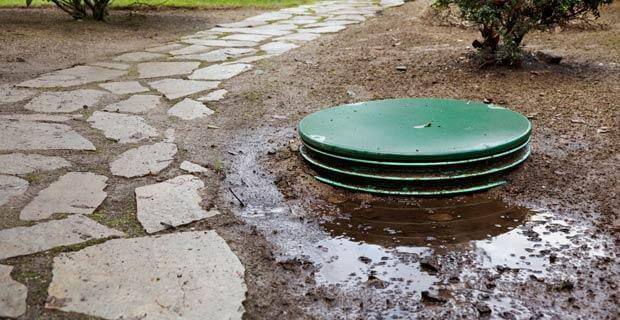Domestic Septic Tanks
At OMDI, we offer expert design, installation and maintenance services for domestic septic tanks in homes and households across the UK.
If you’re a homeowner looking for the most cost-effective, off-mains drainage system, then our domestic septic tank team is here to help you.
With well over 20 years’ experience installing septic tanks for domestic use, our professional experts have the solutions that your home needs.
What Are Domestic Septic Tanks?
Domestic septic tanks are wastewater disposable systems that have been designed for use in a domestic, rather than in a commercial, capacity. They’re tailored for the needs of households and homeowners, rather than businesses or large commercial properties.

Septic tanks for domestic properties consist of a large chamber that’s connected to the home through a series of pipes. The septic tank collects waste from toilets and bathrooms before breaking it down and releasing clean wastewater back into the environment.
How Do Domestic Septic Tanks Work?
Domestic septic tanks work independently of public sewers, offering an incredibly self-sufficient off-mains drainage solution to homeowners. The process is both cost effective and environmentally friendly.
They work by separating waste into distinct layers after it’s been piped into the main chamber of the tank. Solid waste and heavy particles naturally sink to the bottom of the chamber, while liquids collect at the top of the tank.
Bacteria in the septic tank then get to work breaking down harmful substances and anything that’s biodegradable. Broken-down substances are safe enough to be ejected as part of the wastewater into the ground. Wastewater diffuses away into the surrounding environment, often making use of soakaways for increased efficiency and to avoid build-ups of liquid around the tank.
The process is repeated constantly, as the bacteria are self-sufficient within the septic tank’s anaerobic system, and continually work to break down any waste that enters the system. A thin layer of sludge, consisting of non-biodegradable waste, is left behind in the bottom of the tank. This sludge needs emptying periodically to keep the system working efficiently.
Where Are Domestic Septic Tanks Located?
Domestic septic tanks are specifically designed to be used in a domestic setting, which means they are most commonly installed in gardens or outside areas of a property. They’re connected to the home by a network of pipes, allowing wastewater to be flushed directly from the house into the tank.

To keep domestic septic tanks out of sight and ensure that they take up less garden space, they’re often buried below ground level. Septic tanks for domestic purposes are a great choice in rural locations where access to the public sewers is either not possible or expensive.
You traditionally find domestic septic tanks on farms or isolated homes in the countryside. Increasingly however, they’re being installed in more urban areas, offering a cheaper and more environmentally friendly alternative to public sewer systems.
How Much Do Domestic Septic Tanks Cost?
Domestic septic tank systems need to be designed individually and built to order, as each location and home has different requirements and needs.
Naturally the larger the capacity needs to be, the bigger the tank, and the more it’s likely to cost. For example, a two-bedroom house with three occupants will need a smaller tank than a six-person family home.
Building a tank below ground is more expensive than constructing it above ground, however the latter could cost you more in the long run if the tank becomes damaged during bad weather. Likewise, using cheaper materials saves money in the short term, but could be more costly over time than using hardier, more durable materials.
If you already have a septic tank installed and are looking for a replacement, this could be a cheaper project than starting from scratch, as the design can incorporate existing elements of the older infrastructure.

The major factors that affect the price include the following:
- Size of the tank and intended capacity
- Length and distribution of pipes and drains
- Depth and size of installation excavations
- Quality of material used in construction
- Additional extras such as soakaways
- Number of work hours needed to complete design and installation
Once set up, domestic septic tanks are very self-sufficient, but they need intermittent upkeep and maintenance work to function efficiently. Because sludge builds up in the bottom of a tank, it’s recommended to have it emptied and serviced every 12 months.
Yearly servicing will save you on larger repair costs in the future, as professionals will be able to catch problems early on and make maintenance and upkeep recommendations that help the tank to avoid major breakages.
How Long Do Domestic Septic Tanks Last?
Domestic septic tanks can last for decades if they are properly designed, installed and regularly maintained by professionals.
The actual lifespan depends on a number of factors, however. If a septic tank is constructed from concrete below ground and has been serviced and emptied once a year, it could last for 40 years.
Using cheaper materials, missing services or ignoring breakdowns within the system will shorten the lifespan of a septic tank considerably, so it’s important to keep on top of maintenance and repair issues.
Government regulations concerning septic tanks often change too, so it’s important to keep your septic tank up to date and compliant with the latest regulations to avoid having to replace it entirely.
Why Choose OMDI?
At OMDI, we take real pride in offering our clients a truly personalised service, tailored to their needs.
As a family-run business, we know the importance of building long-lasting relationships with our customers. We aren’t just here to install domestic septic tanks but to provide servicing, maintenance and repairs through their lifespan too. For that reason, we take the time to know our customers and to exceed their requirements. If you’re looking for more information on domestic septic tanks, our friendly and professional staff are happy to help you through the design, installation and maintenance process. Contact OMDI today for more information and to obtain a free quote.
